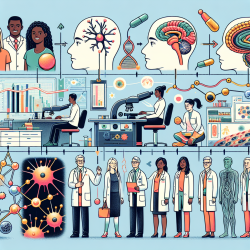Introduction
In the ever-evolving field of speech-language pathology, staying abreast of the latest scientific discoveries is crucial for improving therapeutic outcomes. The recent study titled "Emerging variants, unique phenotypes, and transcriptomic signatures: an integrated study of COASY-associated diseases" offers groundbreaking insights that can significantly enhance our understanding and practice. This research explores the genetic underpinnings and phenotypic expressions of COASY-related disorders, providing a rich tapestry of data that can inform our approaches in clinical settings.
Understanding COASY and Its Implications
The COASY gene encodes CoA synthase, a pivotal enzyme in the biosynthesis of coenzyme A (CoA), which is essential for numerous cellular processes. Mutations in this gene have been linked to rare disorders such as COASY protein-associated neurodegeneration (CoPAN) and pontocerebellar hypoplasia type 12 (PCH12). The study identifies novel COASY variants and their associated phenotypes, including atypical symptoms like language disorders and autism spectrum disorders, which are of particular interest to speech-language pathologists.
Data-Driven Insights for Practitioners
The research employs advanced techniques such as RNA sequencing and bioenergetic analysis to reveal dysregulated gene expressions related to mitochondrial function and oxidative stress responses. These findings underscore the importance of considering mitochondrial health in the assessment and treatment of speech and language disorders. Practitioners can leverage this data to tailor interventions that address the specific needs of children with COASY-related conditions.
Practical Applications in Therapy
- Individualized Assessment: Incorporate genetic and transcriptomic data into the assessment process to better understand the underlying causes of speech and language impairments.
- Targeted Interventions: Develop therapy plans that focus on enhancing mitochondrial function, potentially through dietary modifications or supplements that support CoA biosynthesis.
- Collaborative Care: Work closely with geneticists and neurologists to create comprehensive care plans that address the multifaceted nature of COASY-related disorders.
Encouraging Further Research
This study opens new avenues for research in speech-language pathology, particularly in understanding the genetic and molecular bases of communication disorders. Practitioners are encouraged to engage in collaborative research efforts to further explore the implications of COASY variants and their impact on speech and language development.
Conclusion
By integrating the insights from this research into clinical practice, speech-language pathologists can enhance their therapeutic strategies and improve outcomes for children affected by COASY-related disorders. This data-driven approach not only enriches our understanding but also empowers us to make informed decisions that benefit our young clients.
To read the original research paper, please follow this link: Emerging variants, unique phenotypes, and transcriptomic signatures: an integrated study of COASY-associated diseases.










